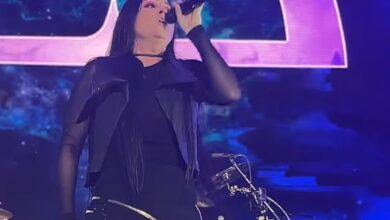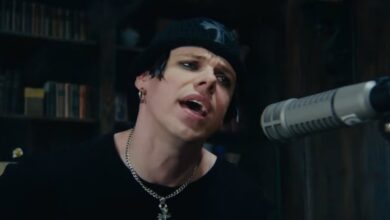The Sound of Silence Transformed by a Haunting Bass Rendition
The first hint that this cover would be special arrived with the name alone: Geoff Castellucci, the subterranean voice of VoicePlay, stepping out for a solo rendition of “The Sound of Silence.” If you’ve followed modern a cappella and cinematic-style vocal productions over the past decade, you know Castellucci as the guy who regularly makes comment sections gasp with impossibly low notes and clever self-harmonizing arrangements. He’s the rare artist whose brand is equal parts range and restraint—big, rumbling fundamentals paired with arrangements that leave air to breathe—so the pairing with Paul Simon’s meditative classic felt less like a stunt and more like a natural alignment of song and singer.
Release day made that hunch official. Castellucci issued “The Sound of Silence” as a standalone digital single on March 10, 2023, putting it out through his independent Kage Records imprint—a playbook he’s used to keep creative control over both the music and the visuals that go with it. That date wasn’t just a timestamp; it was a statement of intent: roll out the audio on streaming the same day you drop the performance video, let the two amplify each other, and meet fans where they already are. Apple Music lists the single, clocking in at about four and a half minutes, under the Kage Records banner.
By the time most fans heard it, the cover was already living a double life—as an audio track for repeat listens and as a mini-movie on YouTube. Streaming platforms gave it permanence and polish; the video gave it a face, a mood, a visual vocabulary. That’s where Castellucci’s approach really sings: he’s as much a director of tone as he is a vocalist, and you can feel it in the pacing of the edit, the measured camera movement, and the way the arrangement slowly adds layers without ever crowding the lyric.
The song, of course, carries a loaded history. Written by Paul Simon, recorded by Simon & Garfunkel in 1964, then reborn with electric overdubs that pushed it into the folk-rock canon, it has survived generation after generation precisely because it rewards reinvention. The lyric’s interior monologue—darkness as a confidant, silence as both threat and refuge—invites singers to choose a path: either soar above it with luminous tenor lines or sink into it, examining the text from the ground up. Castellucci chooses the latter, grounding the verses in sonorous lows that feel like the floorboards of the song itself, then climbing just enough to let the harmonies bloom.
In typical Geoff fashion, the arrangement leans on multi-tracked versions of himself, each “character” voiced with subtly different color. One lane provides the deep-earth foundation; another adds a hushed, breath-rich mid; a third supplies the legato line that threads the phrases together. You hear the producer’s instinct in the way consonants are softened to make room for sustained vowels and in how the lowest voice doesn’t show off so much as stabilize the whole structure.
The visual storytelling mirrors that restraint. Castellucci often places himself in a minimalist, moody environment—shadows, soft key light, and composition that reads as “cinematic close-up” rather than “music-video glam.” The camera lingers long enough to make you hear silence as a character; cuts arrive like breath marks. When the harmony stack enters, the frame widens emotionally even if the shot doesn’t, a neat reminder that dynamics in a video don’t have to rely on quick edits when the audio is doing the heavy lifting.
Fans noticed immediately. Within months, view counts climbed into seven figures, with the clip settling into that rare territory where casual listeners and hardcore vocal geeks share the same comment thread. It became a “send to your friend” link for people who love the original, the Disturbed reboot, or deep-voice performances in general, and that cross-audience energy is a big reason the video keeps getting rediscovered.
Part of the momentum came from the artist’s own copy and community management. Castellucci framed the drop as a response to persistent fan requests, a conversational tone that makes the release feel like an ongoing dialogue rather than a one-way broadcast. Outlets quoted the artist’s description word-for-word—“requested by you lovely folks… I hope you like this version…”—and emphasized the lineage from the 1964 original through modern covers. That gave the piece a second life outside the algorithmic bubble, landing it in inboxes and on timelines you wouldn’t always associate with bass-centric YouTube music.
Another key to the cover’s stickiness is how it handles the song’s crescendo. Rather than racing to the famous lift, the arrangement delays gratification. Verses one and two are almost conspiratorial—low, close, unhurried—before a careful add of upper harmony glints on the line “within the sound of silence.” When the bigger stack does arrive, it reads as earned catharsis: a display of range that serves narrative, not ego.
Production nerds will clock the hallmarks of Geoff’s team: articulate low-end that never muddies, reverb tails that feel architectural rather than syrupy, and clarity in the inner voices so you can parse the counterlines. Across his catalog, you’ll often hear veteran vocal mixers keeping the sonics precise, ensuring transients stay crisp even when the arrangement gets dense. It’s the difference between “lots of tracks” and “a single, breathing choir.”
What’s interesting is how the cover threads the needle between two dominant reference points: the original’s folksy fragility and Disturbed’s cinematic thunder. Castellucci nods to both without mimicking either, leveraging his low register to create gravity while keeping the percussion of the arrangement almost subliminal—more pulse than beat. The result lands in a third space: meditative, nocturnal, and just dramatic enough to make the lyric’s warning feel contemporary rather than nostalgic.
Context matters, too. By 2023, Castellucci had already built a reputation for turning single-song drops into events—think “Sixteen Tons,” “Far Over the Misty Mountains Cold,” and other low-voice showcases that climbed streaming charts and YouTube recommendations. Releasing “The Sound of Silence” as a proper digital single alongside the video wasn’t an afterthought; it’s a distribution model. The Apple Music and Spotify listings make the track easy to playlist, which in turn feeds discovery back to the video.
The cover also benefits from Castellucci’s identity as a group singer who knows how to make one voice feel like many. Years in VoicePlay trained him to hear arrangements as choreography—each part has blocking, motivation, a reason to be there. You can sense that discipline in tiny choices: where one harmony ducks to reveal a consonant, where another sneaks in to color a vowel, how the lowest line sometimes pulls back to let the lyric breathe.
And then there’s the cultural weather. “The Sound of Silence” is one of those songs that gets new life every decade because its themes—alienation, speech without listening, neon gods—refuse to expire. In an era where many covers go maximal, Castellucci’s decision to keep the arrangement focused reads as counter-cultural. He trusts the lyric. He trusts the listener. He lets negative space do some of the talking. That restraint is why the last section lands like a revelation rather than a jump scare; you feel the lift arriving in your chest before it hits your ears.
All of this would be academic if the audience didn’t care, but they do—passionately. Scroll the comments and you find a healthy mix of music-theory breakdowns, faith-flavored gratitude, and simple “I got chills” testimonies. Some fans arrive from Simon & Garfunkel nostalgia, others from Disturbed fandom, still others from the “low voice” rabbit hole that YouTube loves to recommend. It’s rare to see those groups agree on anything, but here they converge on a shared verdict: this cover earns its quiet and its drama in equal measure.
If you’re mapping the professional ledger, the takeaways are simple. The single is cataloged across major platforms with consistent metadata; the video continues to pull steady views well after release; and the artist’s messaging stays personal enough to feel human at scale. The infrastructure is tidy—an indie label imprint, a direct relationship with fans, and an audio-visual pipeline that makes every drop feel intentional. That’s how you turn a one-off cover into a durable asset instead of a flash in the feed.
Ultimately, what makes Geoff Castellucci’s “The Sound of Silence” special isn’t just the headline-grabbing low notes or the flawless production. It’s the way the performance respects the song’s interior world. He doesn’t colonize the lyric with unnecessary decoration; he illuminates it, framing silence as something living, something that pushes back. You walk away feeling like you’ve heard the classic anew, not because he tried to out-sing its past, but because he let its timeless core hum at a frequency only a true bass can reach.





